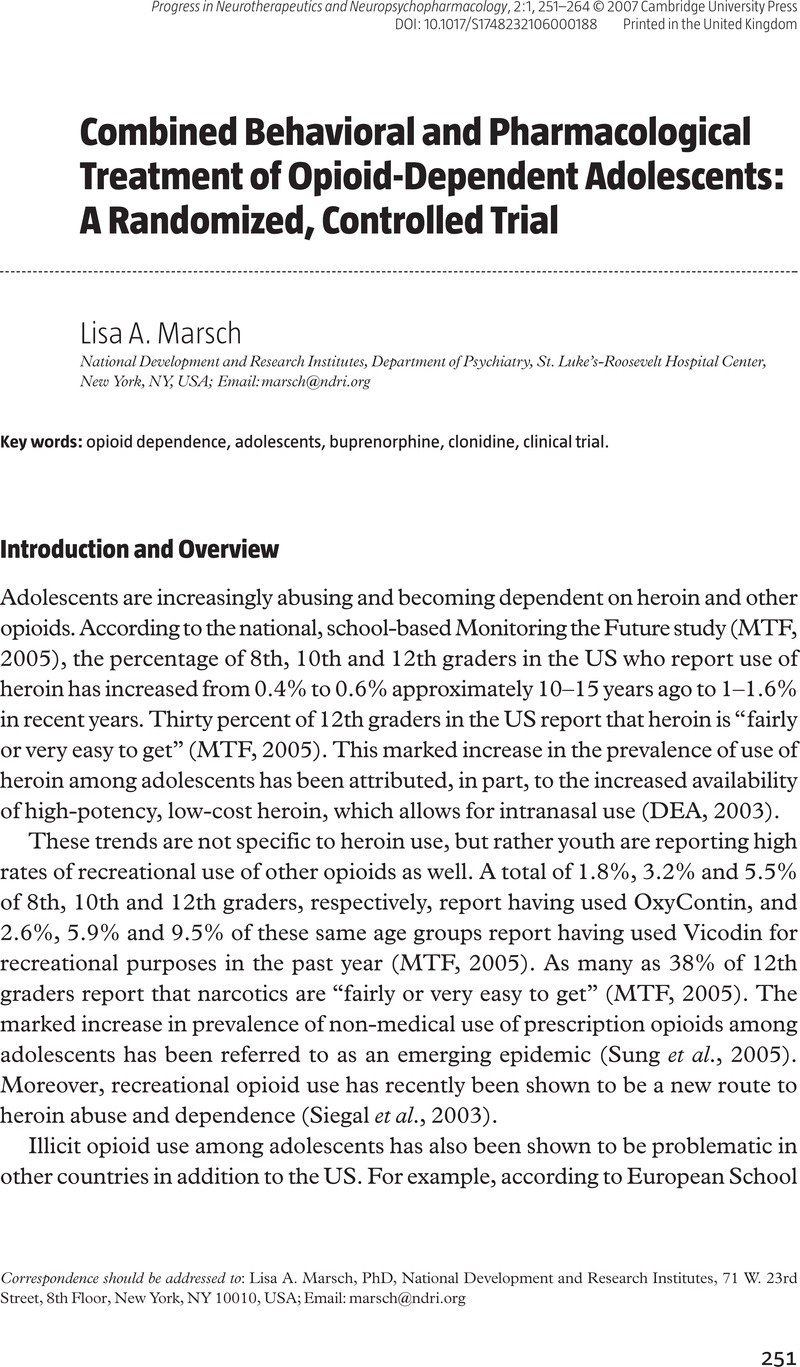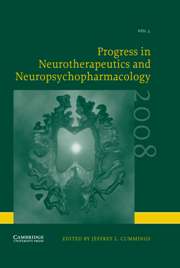No CrossRef data available.
Article contents
Combined Behavioral and Pharmacological Treatment of Opioid-Dependent Adolescents: A Randomized, Controlled Trial
Published online by Cambridge University Press: 05 March 2007
Abstract
An abstract is not available for this content so a preview has been provided. Please use the Get access link above for information on how to access this content.

Information
- Type
- Review Article
- Information
- Progress in Neurotherapeutics and Neuropsychopharmacology , Volume 2 , Issue 1 , March 2007 , pp. 251 - 264
- Copyright
- © 2007 Cambridge University Press
References
Armitage, P. (1983). Exclusions, losses to follow-up, and withdrawals in clinical trials. In: Shapiro, S.H., & Louis, T.A. (eds.), Clinical Trials: Issues and Approaches. New York: Marcel Dekker, pp. 99–113.
Azrin, N.H., Donoue, B., Besalel, V., Kogan, E., & Acierno, R. (1994). Youth drug abuse treatment: a controlled outcome study. Journal Child Adolescent Drug Abuse, 3, 1–16.CrossRefGoogle Scholar
Azrin, N.H., Acierno, R., Kogan, E.S., Donohue, B., Besalel, V.A., & McMahon, P.T. (1996). Follow-up results of supportive versus behavioral therapy for illicit drug use. Behavior Research and Therapy, 34, 41–46.CrossRefGoogle Scholar
Bickel, W.K., & Amass, L.A. (1995). Buprenorphine treatment of opioid dependence. A review. Experimental and Clinical Psychopharmacology, 3, 477–489.CrossRefGoogle Scholar
Bickel, W.K., Stitzer, M.L., Bigelow, G.E., Liebson, I.A., Jasinski, D.R., & Johnson, R.E. (1998). Buprenorphine: dose-related blockade of opioid challenge effects in opioid dependent humans. Journal of Pharmacology and Experimental Therapeutics, 247, 47–53.Google Scholar
Budney, A.J., & Higgins, S.T. (1998). A Community Reinforcement Plus Vouchers Approach: Treating Cocaine Addiction. Rockville, MD: US Department of Health and Human Services, National Institute on Drug Abuse.
Burris, J.F. (1993). The USA experience with the clonidine transdermal therapeutic system. Clinical Autonomic Research, 3, 391–396.CrossRefGoogle Scholar
Camí, J., Torees, S., San, L., Sole, A., Guerra, D., & Ugena, B. (1985). Efficacy of clonidine and of methadone in the rapid detoxification of patients dependent on heroin. Clinical Pharmacology and Therapeutics, 38, 336–341.CrossRefGoogle Scholar
Cheskin, L.J., Fudala, P.J., & Johnson, R.E. (1994). A controlled comparison of buprenorphine and clonidine for acute detoxification from opioids. Drug Alcohol Dependence, 36, 115–121.CrossRefGoogle Scholar
Clemmey, P., Payne, L., & Fishman, M. (2004). Clinical characteristics and treatment outcomes of adolescent heroin users. Journal of Psychoactive Drugs, 36, 85–94.CrossRefGoogle Scholar
Cowan, A., Doxey, J.C., & Harry, E.J.R. (1977). The animal pharmacology of buprenorphine: an oripavine analgesic agent. British Journal of Pharmacology, 60, 547–554.CrossRefGoogle Scholar
Crome, I.B., Christian, J., & Green, C. (1998). Tip of the national iceberg? Profile of adolescent patients prescribed methadone in an innovative community drug service. Drug/Education Prevention Policy, 5, 195–197.CrossRefGoogle Scholar
Darke, S., Hall, W., Heather, N., Ward, J., & Wodak, A. (1991). The reliability and validity of a scale to measure HIV risk-taking behaviour among intravenous drug users. AIDS, 5, 181–185.CrossRefGoogle Scholar
Darke, S., Hall, W., Wodak, A., Heather, N., & Ward, J. (1992). Development and validation of a multi-dimensional instrument for assessing outcome of treatment among opiate users: the Opiate Treatment Index. British Journal of Addiction, 87, 733–742.CrossRefGoogle Scholar
Donahue, D., & Azrin, N. (2001). Family behavior therapy. In: Waldron, H., & Wagner, E. (eds.), Innovations in Adolescent Substance Abuse Intervention. Oxford, UK: Elsevier Science Ltd, 206–227.CrossRef
Drug Enforcement Administration. Illegal Drug Price and Purity Report. US Department of Justice. Available online at: http://www.usdoj.gov/dea/pubs/intel/02058/02058.pdf
Dulcan, M.K., & Martini, D.R. (1999). A Concise Guide to Child and Adolescent Psychiatry. Washington DC: American Psychiatric Press.
European School Survey Project on Alcohol and Other Drugs (2004). Available online at: www.espad.org
Fishbain, D.A., Rosomoff, H.L., & Cutler, R. (1993). Opiate detoxification protocols: a clinical manual. Annals of Clinical Psychiatry, 5, 53–65.CrossRefGoogle Scholar
Fudala, P.J., Jaffe, J.H., Dax, E.M., & Johnson, R.E. (1990). Use of buprenorphine in the treatment of opioid addiction. II. Physiological and behavioral effects of daily and alternate-day administration and abrupt withdrawal. Clinical Pharmacology and Therapeutics, 47, 525–534.Google Scholar
Gal, T.J. (1989). Naloxone reversal of buprenorphine-induced respiratory suppression. Clinical Pharmacology and Therapeutics, 45, 66–71.CrossRefGoogle Scholar
Gitrotra, S., Kumar, S., & Rajendran, K.M. (1993). Caudal buprenorphine for postoperative analgesia in children: a comparison with intramuscular buprenorphine. Acta Anaesthesiologica Scandinavica, 37, 361–364.CrossRefGoogle Scholar
Gold, M.S., Pottash, A.L.C., Sweeney, D.R., & Kleber, H.D. (1979). Clonidine detoxification: a fourteen-day protocol for rapid opiate withdrawal. NIDA Research Monograph, 27, 226–232.Google Scholar
Gordon, S.M. (2002). Surprising data on young heroine users. The Brown University Child and Adolescent Behavior Letter, 18, 1–3.Google Scholar
Harcus, A.W., Ward, A.E., & Smith, D.W. (1980). The monitored release of buprenorphine: release in the young. Journal of International Medical Research, 8, 153–155.CrossRefGoogle Scholar
Hopfer, C.J., Mikulich, S.K., & Crowley, T.J. (2000). Heroin use among adolescents in treatment for substance use disorders. Journal of the American Academy of Child and Adolescent Psychiatry, 39, 1316–1323.CrossRefGoogle Scholar
Hopfer, C.J., Khuri, E., Crowley, T.J., & Hooks, S. (2002). Adolescent heroin use: a review of the descriptive and treatment literature. Journal of Substance Abuse Treatment, 23, 231–237.CrossRefGoogle Scholar
Hunt, R.D., Capper, L., & O'Connell, P. (1990). Clonidine in child and adolescent psychiatry. Journal of Child Adolescent Psychopharmacology, 1, 87–102.CrossRefGoogle Scholar
Janiri, L., Mannelli, P., Persico, A.M., Serretti, A., & Tempesta, E. (1994). Opiate detoxification of methadone maintenance patients using leftemine, clonidine and buprenorphine. Drug Alcohol Dependence, 36, 139–145.CrossRefGoogle Scholar
Jasinski, D.R., Pevnick, J.S., & Griffith, J.D. (1978). Human pharmacology and abuse potential of the analgesic buprenorphine. Archives of General Psychiatry, 35, 501–516.CrossRefGoogle Scholar
Johnson, R.E., Jaffe, J.H., & Fudala, P.J. (1992). A controlled trial of buprenorphine treatment for opioid dependence. Journal of American Medical Association, 267, 2750–2755.CrossRefGoogle Scholar
Kamal, R.S., & Khan, F.A. (1995). Caudal analgesia with buprenorphine for post-operative pain relief in children. Paediatric Anasthesia, 5, 101–106.CrossRefGoogle Scholar
Kleber, H.D., Riordan, C.E., Rounsaville, B., Kosten, T., Charney, D., Gaspari, J., Hogan, I., & O'Connor, C. (1985). Clonidine in outpatient detoxification from methadone maintenance. Archives of General Psychiatry, 42, 391–394.CrossRefGoogle Scholar
Marsch, L.A., Bickel, W.K., Badger, G.J., Stothart, M.E., Quesnel, K.J., Stanger, C., & Brooklyn, J. (2005). Comparison of pharmacological treatments for opioid dependent adolescents: a randomized, controlled trial. Archives of General Psychiatry, 62, 1157–1164.CrossRefGoogle Scholar
Maunuksela, E., Korpela, R., & Olkkola, K.T. (1988). Comparison of buprenorphine with morphine in the treatment of postoperative pain in children. Anesthesia and Analgesics, 67, 233–239.Google Scholar
McLeod, D.R., Griffiths, R.R., Bigelow, G.E., & Yingling, J. (1982). An automated version of the digit symbol substitution test (DSST). Behavior Research Methods and Instrumentation, 14, 463–466.CrossRefGoogle Scholar
Monitoring the Future (2005). Available online at: www.monitoringthefuture.org
O'Connor, P.G., Carroll, K.M., Shi, J.M., Schottenfeld, R.S., Kosten, T.R., & Rounsaville, B.J. (1997). Three methods of opioid detoxification in a primary care setting. A randomized trial. Annals of Internal Medicine, 127, 526–530.CrossRefGoogle Scholar
Preston, K.L., Bigelow, G.E., & Liebson, I.A. (1988). Buprenorphine and naloxone alone and in combination in opioid-dependent humans. Psychopharmacology, 94, 484–490.CrossRefGoogle Scholar
Rance, M.J., & Dickens, J.N. (1978). The influence of drug-receptor kinetics on the pharmacological and pharmaco-kinetic profiles of buprenorphine. In: Van Ree, J.M., & Pereniums, L. (eds.), Characteristics and Functions of Opioids. Amsterdam: Elsevier/North-Holland Biomedical Press, pp. 65–66.
Rounsaville, B.J. (1995). Can psychotherapy rescue naltrexone treatment of opioid addiction? NIDA Research Monograph, 150, 37–52.Google Scholar
Siegal, H.A., Carlson, R.G., Kenne, D.R., & Swora, M.G. (2003). Probable relationship between opioid abuse and heroin use. American Family Physician, 67, 942–945.Google Scholar
Sung, H.E., Richter, L., Vaughan, R., Johnson, P.B., & Thom, B. (2005). Nonmedical use of prescription opioids among teenagers in the United States: trends and correlates. Journal of Adolescent Health, 37, 44–51.CrossRefGoogle Scholar
Walsh, S.L., Preston, K.L., Stitzer, M.L., Cone, E.J., & Bigelow, G.E. (1994). Clinical pharmacology of buprenorphine: ceiling effects at high doses. Clinical Pharmacology and Therapeutics, 55, 569–580.CrossRefGoogle Scholar
Walsh, S.L., Preston, K.L., Bigelow, G.E., & Stitzer, M.L. (1995). Acute administration of buprenorphine in humans: partial agonist and blockade effects. Journal of Pharmacology and Experimental Therapeutics, 274, 361–372.Google Scholar

